I wonder if there’s someone out there who collects library bookmarks? Every library has its own bookmark, like this one from the new Liverpool Library, decades ago.
I wonder if there’s someone out there who collects library bookmarks? Every library has its own bookmark, like this one from the new Liverpool Library, decades ago.
Filed under Bits and Pieces
Waiting in the foyer of the Mitchell Library, I watched a large group of American teenagers filing through. They entered through the door on the left, trailed past the terrazzo map set into the floor while taking photos, then exited through the door on the right. I heard one girl say to her friend “Just one more!” as she paused to take yet another photo. It is a beautiful library, but I was a little surprised at this parade that visited so briefly.
I was sitting in the foyer of the Mitchell Library waiting for the person who would be my partner for The Quiet Volume, described as a “whipered, automatic performance”, taking place in the Mitchell Library Reading Room. As the performance is for two people, you could either bring a friend or be matched up with another person: I chose the latter, and had been wondering all morning who they might be. As it turns out, it was someone I knew, Lara, who had come from her project in Hurstville Westfield. “What a surprise to find you in the library,” she said, and we laughed about the coincidence of not being strangers after all.
We were given iPods and taken in to the Reading room, where specific desks had been set up for The Quiet Volume. I could see other couples sitting together, their performance already started, picking up books, or looking around with pensive, listening expressions. Our table was at the back of the library, near the Special Collections area. I like this area as I enjoy peeking at what people are looking at in there. Recently I was doing some research in the Mitchell and I watched a man going through a box of small squares of yellowed paper, tickets, perhaps. I wondered what they were, but there was no way I could ask, people don’t do that kind of thing in libraries.
The Quiet Volume very much worked with this experience of being in the library, what you can and can’t do, the way your internal voice and thoughts work, the act of reading, and the way you view other people in the library space. Lara and I sat side by side like the others and listened to the voices in the headphones. They alternated between reflections, instructions, silence and sound effects (I particularly liked a moment which had a cacophony of dropped pens). There was a pile of books in front of us, novels and a book of city photographs. We went in and out of these books and stories, our movements somewhere between casual and self conscious, although as we sat there few people paid us any attention. A man nearby frowned into his old laptop, two girls conferred about their studies, both grasping pencils, library staff pushed trolleys back and forth and went in and out of the secret doors at the sides of the Reading Room. When I go to the Reading Room to study it is the sound of these doors opening and closing that punctuates whatever I am doing, and it always makes me think of the secret back rooms of the library, and imagine what must be behind them.
All the regular library activities went on around us as we followed the whispered instructions. Afterwards we agreed there had been a lot of directions, and so much concentration was required. At times I became distracted by the condition of my hands, as they were the only part of my body I was really aware of during the performance. Sometimes my thoughts would drift off and I’d stare at the books that surround the room or look over at people studying, and then realise I’d missed a set of instructions. But it was easy to pick up again.
At the end we sat quietly for a few minutes, observing the last few moments of library quiet, before pushing back our chairs and walking back out to the foyer to return our iPods. We flipped through the guestbook, which had been started in Basel – the work has travelled to many countries. Scanning through them we noticed that people had very eloquent and poetic responses to the performance. I guess that makes sense for an artwork about our relationship to reading and libraries.
The Quiet Volume is by Tim Etchells and Ant Hampton, and you can read a short interview I did with Ant for Time Out here.
Filed under Sydney City
Earlwood library is a red brick building on the high side of the intersection of three main roads. Earlwood is the point in the inner western suburbs when the car becomes the dominant form of transport. Cars race through Homer Street as if something very urgent is awaiting them. From inside the library the roar of traffic can constantly be heard.
The library is a 1950s red brick building situated on a wedge of land, with an early childhood health centre at the very tip of the intersection. In front of the entrance is an uninviting fenced courtyard with wire benches and a view over the intersection and shops of Homer Street below (many old advertisements for photo processing, a diving smelling Continental cake shop, a bottle shop with a big bottle of Retsina painted on the front window).
No one was using this unappealing perch, despite the view. Just inside the entrance to the library was a row of plaques commemorating local authors, a detail I have seen at no other Sydney library. The Earlwood authors are Nadia Wheatly, Debra Adelaide, Joan Dugdale and Leslie Haylen, and each plaque had a quote and a date in 1999 on it, perhaps when the plaques were unveiled.
At the back of Earlwood library is a Viking ship, with a shiny gold eye, and striped sail. As I wandered around it seemed to watch me. It was an after school kind of time, and the only people in the library were school students. A girl with a huge pile of lever arch folders, so many I couldn’t imagine her carrying them in a schoolbag, eating tabbouleh from a plastic container and reading her notes. A girl using one of the computers, taking notes on her arm with a felt tip pen. Her arm already had a lot of notes on it, but she continued to write. I thought of offering her some paper but only had a tiny notebook. Around the corner from the arm notes girl was a boy sitting in a corner reading a book called “Storm of Swords”.
Affixed to a cupboard door was a laminated poster of a man smiling and holding a book, with the background of a galaxy in deep space. Down one side was the legend READ. I looked from the poster to the man behind the desk – it was the same guy. I like the idea of DIY literacy posters.
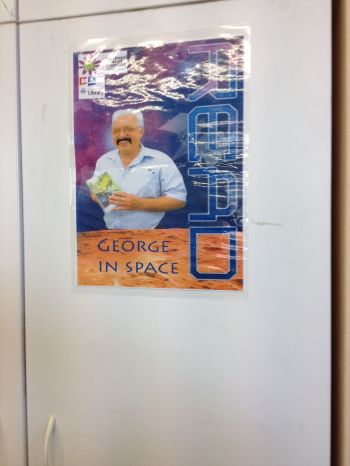
Around the corner was another poster encouraging people to read. This one was in the teen area, and a little more polished than George in Space. Who do you find more compelling?
On the top of the non fiction shelves was a large book about volcanoes, Earth on Fire. It was a big, heavy book with a photograph of hot lava showing through the cracks in a black landscape. I don’t know if Earth on Fire was usually shelved up there, but I took it down for further investigation. It is hard to believe that the world contains all these volcanoes and geysers, black sand beaches, smoking craters and strangely coloured lakes. Mutnovsky Volcano! The Grand Prismatic Spring! Some of the photographs of the brighter volcanic lakes made me feel as if I was hallucinating.
Behind the Morning Glory Pool in this photo is the Valley Times, which this week had a cover story about the 2012 Premier’s Spelling Bee. The local student pictured on the front just missed out on the title of Senior State Champion because she incorrectly spelled the word “rhododendron”. She will hate rhododendrons for the rest of her life! I wondered about her being pictured in a thoughtful pose under the word, as she probably relives the moment of misspelling that word with mortification.
I returned Earth on Fire to its spot on top of the shelf. On the way there I could see that the arm notes girl had stopped taking notes and was now looking at positions vacant on the McDonalds website. On the wall above the computers where she was sitting was a framed painting of the Earlwood tram terminus. Though trams stopped running in 1957, they are a ghost presence in Earlwood, the terminus is marked on the street corner, where there is now the Senior Citizens Centre.
Across from the the once-tram terminus and the library is a small, sedate park, with lawn and benches, however the peaceful ambience is ruptured somewhat by a warning sign.
There may not be volcanoes in Earlwood, but that doesn’t mean it is safe.
Filed under Inner Western Sydney
I wondered about it during my visit to Rockdale library, but here I have conclusive proof of the Sydney Subject Specialisation Scheme (or SSSS – what an acronym), a scheme in which Sydney public libraries would specialise in a particular subject, the idea being that, across the Sydney metropolitan library network, there was held a comprehensive collection, which could then be accessed by interlibrary loan. While the scheme has been discontinued, these areas of specialisation can still be detected in library collections. How the topics were divided up, I’m not sure. Hornsby, for example, collected The Bible, Linguistics and Cookery.
This information comes from “Sydney Inside Info”, an alternative guide book to “help you get Sydney before it gets you”, published in 1979.
More comprehensive lists can be found here along with everything you might ever need to know about inter-library loans in NSW.
Filed under Bits and Pieces
 While this photograph may seem to be of a streetlight, behind it lurks Greenacre Library. Housed in a long and thin building, the library is surrounded by lawn and there is a large park behind it. It’s adjacent to the Early Childhood Centre, a common coupling of community buildings. Never have I noticed an Early Childhood Centre to be open, in my mental map of the city they are small, secret buildings that inside I imagine to be decorated in 1970s style, with lots of posters on the walls.
While this photograph may seem to be of a streetlight, behind it lurks Greenacre Library. Housed in a long and thin building, the library is surrounded by lawn and there is a large park behind it. It’s adjacent to the Early Childhood Centre, a common coupling of community buildings. Never have I noticed an Early Childhood Centre to be open, in my mental map of the city they are small, secret buildings that inside I imagine to be decorated in 1970s style, with lots of posters on the walls.
Conforming to this belief, the Early Childhood Centre was closed, and there was no chance of peeking in through the windows. The library, however, was open.
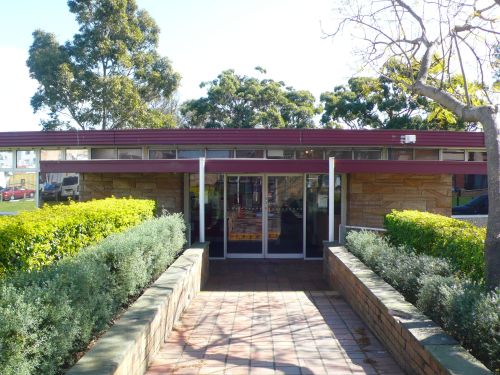 I waited for a librarian dragging a large blue wheelie bin to enter the library before I stepped inside, to a conversation between librarians about the bins. Around the librarians desk were festoons of stationary available for purchase, which I have seen at no other library, but is a good idea. I once heard tell of a vending machine in a university library that sold stationery, and other things students might need that weren’t food or drinks. Being a fan of vending machines, I hoped to come across such a machine, imagining it to sell things like pens, earplugs, USB sticks, tissues, hand cream, panadol, paperclips…or just pens, as in the example below.
I waited for a librarian dragging a large blue wheelie bin to enter the library before I stepped inside, to a conversation between librarians about the bins. Around the librarians desk were festoons of stationary available for purchase, which I have seen at no other library, but is a good idea. I once heard tell of a vending machine in a university library that sold stationery, and other things students might need that weren’t food or drinks. Being a fan of vending machines, I hoped to come across such a machine, imagining it to sell things like pens, earplugs, USB sticks, tissues, hand cream, panadol, paperclips…or just pens, as in the example below.
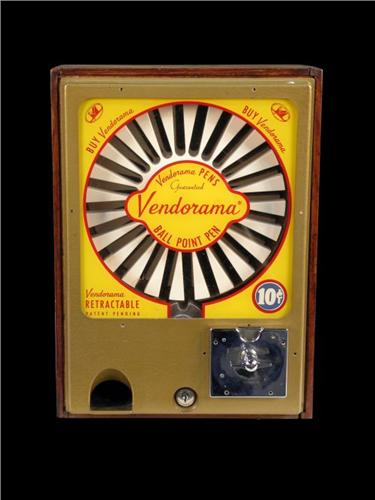 The interior of Greenacre library was easy to imagine as the interior of a ship, as the building is a slight crescent shape, and the walls are wood panelled. I imagined it floating in an ocean of lawn as I surveyed the shelves. I was drawn to the cookbooks section because of a large CWA cookbook. My interest in the CWA had been piqued by a performance art action that I’d gone to see the day before, by the Brown Council. They baked all 137 cakes from one particular CWA cookbook over 90 hours. The book they used was called ‘Jam Drops and Marble Cake’, and featured classic cakes, but the one I looked at had all courses covered. I decided to open up a page at random and see if I would cook the recipe I found there.
The interior of Greenacre library was easy to imagine as the interior of a ship, as the building is a slight crescent shape, and the walls are wood panelled. I imagined it floating in an ocean of lawn as I surveyed the shelves. I was drawn to the cookbooks section because of a large CWA cookbook. My interest in the CWA had been piqued by a performance art action that I’d gone to see the day before, by the Brown Council. They baked all 137 cakes from one particular CWA cookbook over 90 hours. The book they used was called ‘Jam Drops and Marble Cake’, and featured classic cakes, but the one I looked at had all courses covered. I decided to open up a page at random and see if I would cook the recipe I found there.
Jelly Crystal Biscuits were not what I expected to discover! The recipe was from a woman whose first name was Berris, which seemed like a very CWA name to me, a mixture of Beryl and Phyllis. I looked at the names of the woman who’d provided the recipes: Joyce, Phyllis, Wilma, Bev, Noela…some women were very prolific, Joyce especially.
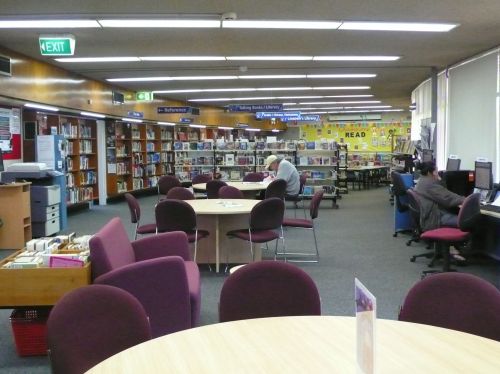 It was a peaceful day in the library, a few people looking at books, a white-gloved librarian quietly putting books away in the children’s section, and a few people on the computers. I browsed around the non fiction section and got stuck on the unlikely choice of The Book of Awesome.
It was a peaceful day in the library, a few people looking at books, a white-gloved librarian quietly putting books away in the children’s section, and a few people on the computers. I browsed around the non fiction section and got stuck on the unlikely choice of The Book of Awesome.
As I am known to be rather a pessimist at times, my interest in this book might seem unlikely. But I was genuinely curious about what things in life might be termed “awesome”. It’s not a word I use a lot, although I, like many others, overuse its cousin, “amazing”. What experiences are awesome, according to Neil Pasricha? Well, things like: hanging your hand out the car window, sitting next to someone good looking on a plane, when you manage to squeeze out just enough toothpaste for one last brush, and getting into a bed with clean sheets after shaving your legs. All entries end with the word AWESOME in capital letters, a pattern which is upheld on the blog of 1000 Awesome Things. Some of the things on there are silly, but I did laugh at the Man Couch entry. The Book of Awesome was shelved in among the study guides, perhaps as a message of hope to those needing to consult the York notes on To Kill a Mockingbird.
The main decorating motif in the bookshelves which lined the walls were a series of faces with different expressions, hinting to the variety of emotions reading can inspire. How did I feel about the Book of Awesome? Worried that when I drove home with my arm out the window, it would be ripped off by a passing truck.
Before I left Greenacre Library I peeked into a room on the side, which was a study area. A boy sat at a desk, bending over his notebook so much so that his nose was almost touching the paper. It looked like a nice place to study, though, looking out over the lawn outside, where a number of black, glossy crows were pecking at the grass. I left the peaceful hull of the library and went out into the sunshine.
Filed under South Western Sydney
Haberfield Library is inside the Haberfield Centre, entered through a series of automatic doors. The first set of automatic doors swing, rather than slide open, an action which is rather ghostly, as if two invisible footmen have swept open the doors upon seeing you approach.
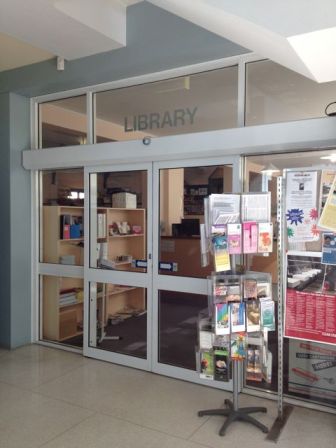 It was a Monday morning, and the library had been open for less than an hour. The librarian at the front desk was sipping from a mug (I hoped it was a library-themed mug: “Old Librarians Never Die They Just Check Out”, but it was the kind of floral/abstract patterned mug normally found in workplace kitchens) and I greeted her as I entered. The desk was directly opposite the entrance, so it would have felt rude not to.
It was a Monday morning, and the library had been open for less than an hour. The librarian at the front desk was sipping from a mug (I hoped it was a library-themed mug: “Old Librarians Never Die They Just Check Out”, but it was the kind of floral/abstract patterned mug normally found in workplace kitchens) and I greeted her as I entered. The desk was directly opposite the entrance, so it would have felt rude not to.
The library once must have been a hall, as it had lofty ceilings and an elevated stage area at one end, which was now the children’s book section. The walls were painted a pale pink with blue trim and this colour scheme, coupled with the sense of hush prevailing in the library, gave it a peaceful ambience. There were a few people here and there, a Justice of the Peace was set up at one of the tables with a pile of papers and a series of rubber stamps, waiting for people to get documents certified; a few men were browsing the shelves. I sat at a table which had a fresh copy of the Sydney Morning Herald on it and I opened it up to read the front page. I had only skimmed over the headlines and half read an article about cycleways when my attention was drawn towards the biography section, and I got up to investigate it. It was a good thing I had: about 30 seconds later a man entered the library and moved with great speed towards the newspaper on the table. He was a classic newspaper man, wearing a cap and glasses, and he proceeded to read every page thoroughly. I don’t like to think what might have happened if he’d come in and discovered me reading the paper that was rightfully his.
 Haberfield and Ashfield libraries, libraries which are in the same “family”, both have a large biography section. I don’t read many biographies but I do like biography sections in libraries, because you can a play a version of one of those games where you have to list what famous people you’d invite to a dinner party. Except rather than your carefully chosen list of heroes, you have to have dinner with the people who appear on the shelves in alphabetical order. So here, for example, if you choose P, you will have to have dinner with Cole Porter, Beatrix Potter, Prince, and Marcel Proust, among others.
Haberfield and Ashfield libraries, libraries which are in the same “family”, both have a large biography section. I don’t read many biographies but I do like biography sections in libraries, because you can a play a version of one of those games where you have to list what famous people you’d invite to a dinner party. Except rather than your carefully chosen list of heroes, you have to have dinner with the people who appear on the shelves in alphabetical order. So here, for example, if you choose P, you will have to have dinner with Cole Porter, Beatrix Potter, Prince, and Marcel Proust, among others.
Other games that you can play with the biography section include, for the narcissistic, working out where your biography would appear on the shelf, or just reviewing who has had their biography written. Sometimes it’s surprising. Dr Harry Cooper has a biography. So does Kiefer Sutherland.
The biography section was popular, even though there were few people in the library there were two earnest browsers, a woman clutching a biography of Kathryn Hepburn (I wonder if she knows about Kathryn Hepburn’s brownie recipe, or as I call them, the Hepbrownies?) and a man slowly making his way through the shelves from a (ABBA) to Z (“How Murderball Saved My Life” by Mark Zuppa).
After looking through the biographies for a while and imagining unlikely dinner parties, I looked around the library further. At either side of the ‘stage’ were plaster Greek goddesses, presiding over the racks of CDs and shelves of children’s books. It was their presence and the high ceilings which gave the library its sense of peace and order, I think. When library architecture more resembles a shopping mall, people are much noisier. 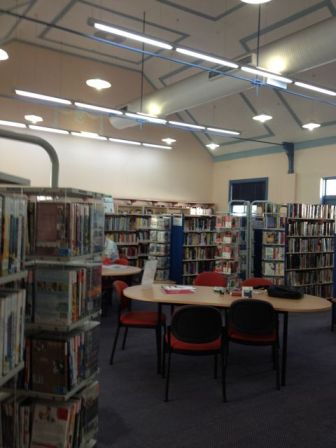 I moved to the magazine area and sat near a woman reading the Italian newspaper La Fiamma. I had a book about 21st century sound art I had discovered on a shelf next to a book about art deco design, one of those books I assumed is the only one about its topic and thus marooned on the shelf, although it could have just been in the wrong place. Now there are certain stereotypes about sound art, and when I opened the book at a random page and was confronted with a two page spread of a man screaming into a microphone, wearing a raw slab of meat on the top half of his head, these stereotypes were not dispelled. I quickly turned the page so the nonna reading La Fiamma wouldn’t see, not that she was looking.
I moved to the magazine area and sat near a woman reading the Italian newspaper La Fiamma. I had a book about 21st century sound art I had discovered on a shelf next to a book about art deco design, one of those books I assumed is the only one about its topic and thus marooned on the shelf, although it could have just been in the wrong place. Now there are certain stereotypes about sound art, and when I opened the book at a random page and was confronted with a two page spread of a man screaming into a microphone, wearing a raw slab of meat on the top half of his head, these stereotypes were not dispelled. I quickly turned the page so the nonna reading La Fiamma wouldn’t see, not that she was looking.
By now a few more people had entered the library, although all of them, even the children, spoke in whispers. Haberfield must be the quietest library I have visited for some time, although maybe it was just the time of day. It was nice sitting in the magazine section, with sun coming in from the windows. I closed the sound art book and looked around, noticing an unusual framed picture behind the magazine racks:
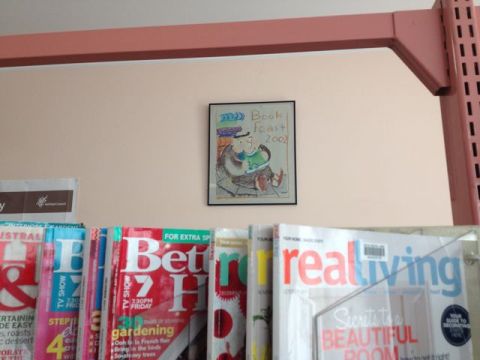
There was a strange melange of symbols in the Book Feast poster: the monk chewing on the book with an avid expression and a row of savage white teeth. I would like to see an exhibition that collected together library/reading initiative posters. I have come across a few while writing Biblioburbia, the Muppets themed one in Avalon library, “Destination Information” at Engadine. Book Feast was the first that encouraged actually chewing on the books, but people do conflate eating and reading, saying they “devoured” a particularly interesting book. And there are often crumbs to be found inside library books.
Before I left Haberfield library I had a look at the rack of 50c book sale books near the entrance. There was a good selection of them but one stood out to me in particular: “Behind the Lines” by J.T. Wilson. His name was familiar…why? When I pulled out the book, I remembered.
Anyone who hung around in Newtown about ten years ago would have come across J.T. Wilson, who set up his ad-hoc short story stall on King St and could often be seen exactly as pictured on the front of his book. “New Stories, All Written in Newtown!” Though I had passed by J.T. Wilson many a time, I had never read one of his stories – here was my chance, and so this book was my souvenir from Haberfield Library.
Filed under Inner Western Sydney
Springwood, in the lower Blue Mountains, is a busy place on Saturday morning. Amid the general bustle of a sunny weekend morning, the Vinnies was seething with people, there were tables set up along the street with sausage sizzles in progress (at one you could buy a cup of cask wine to go with your sausage), stalls selling raffle tickets with which you could win a dinner for two in Leura.
The Springwood Library is just beyond the stretch of shops, in a brick bunker of a 70s building with two signs warning people not to skateboard in the vicinity of it or its tempting sloping footpaths.

Just inside the doorway was a wall of pamphlets, for book clubs, bird watching clubs and other such Blue Mountains activities, neatly arranged in perspex holders. This is also where the stray bookmarks are deposited. A number of libraries I’ve visited have collections of lost bookmarks, although this is the only one which has displayed them so prominently. As much as I have tried to use proper bookmarks, I always seem to lose them and end up using a receipt or a scrap of paper instead. Bookmarks are a sign of the kind of organised person I have not turned out to be.
At the door was a table with for sale books on it, and beyond that a red-painted alcove with some knitting-in-progress on the table. On the wall behind it was an advertisement for a knit in, to take place in the library on the third of August. Was the knitting just there to attract attention for the knit in? I looked around at the people in the library and none seemed to be taking a break from knitting. The waiting knitting carried with it a strong sense of presence but I wondered whether it was actually the start of a scarf or a jumper or just a prop. I could have pondered the knitting for some time but instead I went to look at the books on the new arrivals shelves.
The most interesting book out of all those in the new arrivals section was one titled The Good, The Bad, and the Ugly. At first I thought it was a book designer’s attempt to make the book look DIY, then I realised that it was actually a book made by the library, a notebook that was about a third full with handwritten book reviews. This book had a barcode attached to it, so you could borrow it to read reviews or to add your own. Many of the reviews were done by one person, whose neat handwriting and photocopied illustrations made me think – librarian. But I equally like the idea of one very eager library user, making weekly contributions to The Good, the Bad, and the Ugly, taking the time to photocopy relevant illustrations and sticking them in alongside their review.
I had only a few minutes to look around Springwood library, and so made a quick assessment of the key areas. I noted the man established in a sunny corner reading through the Saturday paper – surely the most satisfying of all weekly papers for the newspaper reading men of the library, being the longest. In the opposite corner of the library, past the computer terminals where a few people were hunched, browsing the internet, was a bookshelf full of telephone books. I hadn’t seen phone books kept in a library before, being more used to encountering them in the post office (although I haven’t noticed them in post offices for a while, they have probably been replaced by picnic sets, 3 packs of kids’ books, and digital photo frames, among the proliferation of post shop tat). In the days when phone books were a more essential part of daily life, I would get a jolt seeing phone books for other cities. I have always liked phone books, it is like being able to hold entire cities in your hands.
Filed under Blue Mountains, Not Sydney
I sat under the liquidambar tree beside the library, eating a salad roll. The tree was next to the library carpark and a man was sitting in the driver’s seat of a dark blue Ford, reading a library book. Rather than watch him I turned the other way so I was facing the street and the row of identical tiny brick houses across the street.
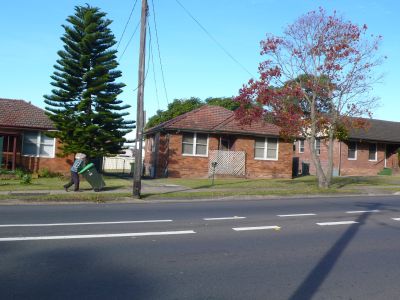
These brown brick houses face the white bricks of Riverwood library. I’m fond of the appearance of this library, its 70s brick symmetry, flat roof, series of hedges, and its letterbox (not a feature I’ve noticed at any other library). It looks both solid and inspiring, which was no doubt the aim of the architect.
At the entrance was a bronze plaque that detailed the library’s opening in 1971, as well as two other noticeboards with council information and opening hours, both of the type where little white letters are stuck to the ridged black board behind. This is my favourite kind of noticeboard, it reminds me of the rubber stamps you assemble from individual letters, and would probably be as maddening to change, with an alphabet soup of individual letters to search through. The sign for the opening hours was made up of tiles which clicked into the background:
Inside the library there were a lot of men in caps reading newspapers at the tables, as there usually is. All was as expected. The caps were for some kind of sporting team, or the kind of promotional cap one gets for free. The men were over 50, probably retired, both holding newspapers but having a vigorous conversation in Chinese. Beside the men was a surly teenage boy drinking a Dare choc milk and reading a book about World War 2, whether for school or for pleasure, I don’t know. I suspect the latter as he wasn’t in school uniform and he looked old enough to have left school. The is something unnerving about young war enthusiasts.
I heard a sound I hadn’t expected to in the library: the click clack of a sewing machine. Yes, there was a sewing machine set up in the kids area, near the bookshelf shaped like a caterpillar, and two women were sitting at it. One was giving the other a sewing lesson. Piled up on the table were plastic containers of sewing bits and pieces. The teacher leaned in to inspect her students’ work. Both were quite young, and I wondered whether the sewing lessons were a feature of the library, or a private teacher using the space. I thought of high school sewing lessons and how happy I’d felt when I could thread the machine properly, it made me feel very competant. I still feel competant, on the odd occasion I do it.
With the hum of the sewing machine in the background I looked over the non-fiction books. Riverwood is a reasonably small branch library so I’d be looking at books about self help and then books about how to play tennis, without quite having noticed the shift. I had been having one of those days on which I break my favourite teapot, bump my head on the corner of a cupboard and spill a whole container of Ecco cereal beverage on the floor (and that stuff is sticky, I tell you). Have I done these three things together before? Maybe not. But I knew the type of day well.
For guidance I picked up the book Smile or Die: How Positive Thinking Fooled America and the World by Barbara Ehrenreich. I’d read her book Nickeled and Dimed about surviving on minimum wage in America and found it pleasingly sparky, but when I opened this book to the dedication and read: “To complainers everywhere: Turn up the Volume!” the thought of living in a world loud with complaints made me shudder. Despite a habit of whinging, I complain publicly rarely, but in fact a few days earlier I’d complained at Marrickville library, in the cranky way of someone who has, for the second time, been told they can’t borrow a book because it is on hold to someone else, even though it is just sitting on the shelf (“Is that how it works,” I said, “you wait until someone wants to borrow it and get them to find it on the shelf for you?” What a grump. Sorry, librarian friends, for being one of those people.)
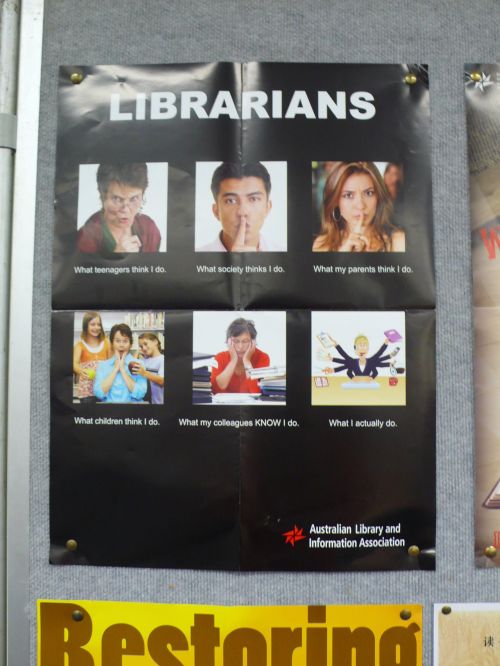
This poster details attitudes towards librarians! The truth is portrayed as a kind of librarian Vishnu.
Her main argument in the book is that, rather than being forced to be positive, being realistic is a far more useful and healthy attitude. As I pondered this I looked across to the computers. They were fairly close by and I could see what the man closest to me was watching on youtube, “Nuba and Harley mating time”, a video of two Greater Swiss Mountain Dogs mating that has been viewed almost 3 million times. Was his interest personal or professional? I didn’t want to think about it too much.
Over at the desk a jovial conversation about hair was going on between the two men working at the library, a man borrowing books, and another man just chatting. The latter man was wearing a brown and yellow beanie and glasses with thick black frames. He’d been hanging around for a while, concerned with the ergonomics of the librarian’s desk and computer set up. This not getting much of a response he moved onto talk of the librarian’s recent haircut: “Looks a bit better but you didn’t get any on the top.” From this, a long conversation about bald patches ensued, each man rubbing their own bald patch as they spoke.
The atmosphere in Riverwood library was quite loud and jolly, with the sewing lesson, the bald patch conversation, and other sonic interruptions, such as the shuddering every time the automatic door opened. It sounded like a truck had roared past and shaken the windows, which is what I thought it was, at first, before realising it was the automatic door.
I glimpsed the computer screen again – now the man was watching a video of camels mating. I faced the situation with realism and decided I felt a bit disturbed by this, put my book back, and left through the shuddering door to the sunny afternoon outside.
Filed under South Western Sydney
Come along to the State Library next Tuesday, June 12th, at 6pm and you will hear me talking about Biblioburbia. My favourite libraries, strangest observations, and some reflections on exploring the suburbs through libraries, and why someone might devote a fair amount of her time doing so. I’ll be bringing along some of my zines also, and, importantly, wearing my most librarian outfit (all the way from the GDR).
For more details see the State Library website here.
Filed under announcements
I’ve made a Biblioburbia you can hold in your pocket – a library card size zine which has entries for each library I have visited.
I sold out of it at the MCA zine fair last weekend, but have put together some more, which you can order on my Etsy shop, or by contacting me directly.
The stories inside are moments from this blog, different ones from the stories included on the Biblioburbia Map. The map came out of hiding and was pored over by many at the MCA zine fair.
A number of people have asked me what is happened with Biblioburbia: I will still be writing here occasionally, however most of my operations are moving to my new blog, Mirror Sydney. See you there!
Filed under announcements, Bits and Pieces